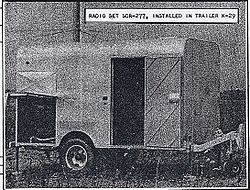
SCR-277
Encyclopedia
The SCR-277 was a mobile, trailer mounted radio range set
for radio guidance of aircraft
. It was standardized by the U.S. Army in June of 1941.

but without a radio compass, within a range of approximately 300 miles. It included the BC-467 transmitter with an RF
output power of 800 watt
s, the BC-468 Goniometer
, and BC-342
receiver. Frequencies utilized were 200-400 KHz for transmission and 1.5-18 MHz for reception. It was powered by a single PE-90 generator.
Signal Corps Radio
Signal Corps Radios were U.S. Army military communications components that comprised "sets". Under the Army Nomenclature System, SCR initially designated "Set, Complete Radio," and later "Signal Corps Radio," though interpretations have varied over time....
for radio guidance of aircraft
Aircraft
An aircraft is a vehicle that is able to fly by gaining support from the air, or, in general, the atmosphere of a planet. An aircraft counters the force of gravity by using either static lift or by using the dynamic lift of an airfoil, or in a few cases the downward thrust from jet engines.Although...
. It was standardized by the U.S. Army in June of 1941.

Specifications
The SCR-277 was used as a navigation aid and included radio range homing equipment for broadcasting tone identification signals to aircraft fitted with standard command setsARC-5
The AN/ARC-5 Command Radio Set is a series of radio receivers, transmitters, and accessories used to provide two-way Morse code and AM radiotelephone communication for U.S. Navy aircraft during World War II and the years following. It was an improvement of the Navy's ARA/ATA command set. Similar...
but without a radio compass, within a range of approximately 300 miles. It included the BC-467 transmitter with an RF
Radio frequency
Radio frequency is a rate of oscillation in the range of about 3 kHz to 300 GHz, which corresponds to the frequency of radio waves, and the alternating currents which carry radio signals...
output power of 800 watt
Watt
The watt is a derived unit of power in the International System of Units , named after the Scottish engineer James Watt . The unit, defined as one joule per second, measures the rate of energy conversion.-Definition:...
s, the BC-468 Goniometer
Goniometer
A goniometer is an instrument that either measures an angle or allows an object to be rotated to a precise angular position. The term goniometry is derived from two Greek words, gōnia, meaning angle, and metron, meaning measure....
, and BC-342
BC-342
The BC-342 was a World War II U.S. Army Signal Corps radio receiver with high frequency band coverage. It was a 115 Volt AC version of the BC-312 receiver, used primarily as part of field installations...
receiver. Frequencies utilized were 200-400 KHz for transmission and 1.5-18 MHz for reception. It was powered by a single PE-90 generator.
Use
In operation the transmitter sends out signals coded "A" or "N" in each of the four quadrants around the beacon. The signals overlap on the range, providing the pilot of the aircraft an indication of his position in relation to location of the beacon. Thus, if he is heading toward the beacon he will receive an aural signal coded "A" or "N" if he is between the beam, and when he is on the beam he will receive "AN" signal. Over land areas the beacon has a range of about 300 miles, while over water areas the range is extended to about 1,000 miles. Charts prepared for air navigation show the position and the orientation of the various beacons.See also
- Low Frequency radio rangeLow Frequency radio rangeThe low-frequency radio range , also known as the four-course radio range, LF/MF four-course radio range, A-N radio range, Adcock radio range, or commonly "the range", was the main navigation system used by aircraft for instrument flying in the 1930s and 1940s, until the advent of the VHF...
- Signal Corps RadioSignal Corps RadioSignal Corps Radios were U.S. Army military communications components that comprised "sets". Under the Army Nomenclature System, SCR initially designated "Set, Complete Radio," and later "Signal Corps Radio," though interpretations have varied over time....
- List of U.S. Signal Corps vehicles
- List of U.S. military vehicles by supply catalog designation (G705)
- Radio navigationRadio navigationRadio navigation or radionavigation is the application of radio frequencies to determine a position on the Earth. Like radiolocation, it is a type of radiodetermination.The basic principles are measurements from/to electric beacons, especially...
- LORANLORANLORAN is a terrestrial radio navigation system using low frequency radio transmitters in multiple deployment to determine the location and speed of the receiver....
- SHORANSHORANSHORAN is an acronym for SHOrt RAnge Navigation, a type of electronic navigation and bombing system with a precision radar beacon used in the B-26 and B-29 bomber aircraft during the Korean War.-Origin:...
- Lorenz beamLorenz beamThe Lorenz beam blind landing system was an air radio navigation system in use from the late 1930s. The name refers to the company that produced the system; Lorenz referred to it simply as the Ultrakurzwellen-Landefunkfeuer, German for "ultra-short-wave landing radio beacon", or LFF...
External links
- http://www.gordon.army.mil/ocos/museum/equipment.asp scr and bc lists
- http://www.footnote.com/image/55724004/#55721259

